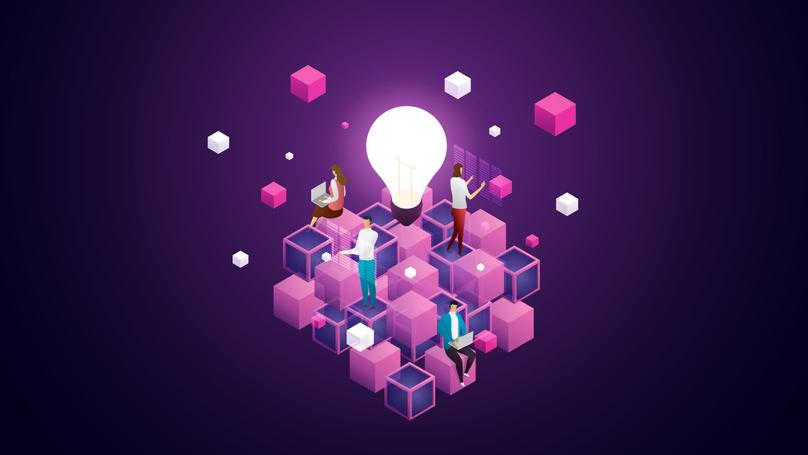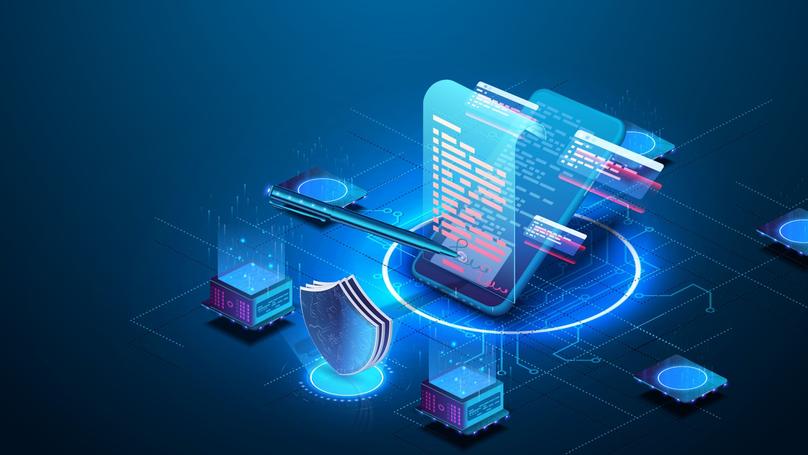Blockchain

What is a blockchain?
Blockchain technology exists within the crypto universe and in various other realms of our activities. It facilitates real estate transactions and logistics processes and is the backbone for many instant messengers and banking systems. However, what exactly is this technology?
Blockchain represents a unique registry or a transaction database with a continuous sequential chain of digital blocks. Therefore, in direct translation, a blockchain is called a chain of blocks. Each element contains information about the previous and next blocks. The entire chain will collapse if any of them is changed or deleted. In this manner, data stored on the blockchain is safeguarded against falsification.
Furthermore, accomplishing this task takes much work. Suppose an attacker chooses to conceal and delete their transaction data. In that case, they must perform this action across all computers on the network, not just on their server. This defines decentralization in the blockchain. When control and decision-making authority within the network is decentralized among its users, it does not rest solely with a single entity, such as a government or corporation.
Blockchain is a secure and reliable way to store and process digital assets online. These assets can vary greatly, including money, shares, art, game characters, and other attributes.
How does a blockchain work?
Blockchain technology operates similarly to spreadsheets and databases, serving as a shared ledger for storing information. The key difference is how this information is distributed and accessed.
Blockchain consists of special programs called scripts. Their primary functions include data entry, access provision, and storage. Let's explore how one of the most common transactions-international money transfers-is carried out. Without the use of blockchain technology, this process typically involves:
-
Contact your bank, who will become an intermediary for this transaction.
-
Providing relevant data about the recipient and the transfer amount, which is communicated to the bank.
-
The bank verifies the received data.
-
A signal regarding the transfer is transmitted to the payment system.
If blockchain technology is employed for transfers, there is no need for banks or any other intermediaries. Everything occurs in four main steps:
1. Recording a transaction reflects the movement of assets from one party to another.
2. Reaching consensus or confirming that the entry is valid.
3. Block chaining - transactions are then recorded in blocks and encrypted.
4. Shared access to the registry: automatic transmission occurs when an updated copy of the central registry is sent to each participant.
The following key factors inherently safeguard the security of transactions within the blockchain network:
-
A secure digital wallet
It is an alternative to a bank account. Such a wallet could consist of an application or computer program, a physical medium such as a USB flash drive, a bank card, or even a paper with a printed QR code. When completing a transaction and transferring money, you must provide the recipient's wallet address, the transfer amount, and the commission. Digital wallets significantly streamline fund transfers, ensuring user anonymity by revealing only wallet numbers on the network.
-
A digital signature
Verifying the transaction using a digital signature becomes essential when a user sends all the necessary transfer data. To achieve this, users employ a private key. This distinct encrypted phrase establishes a connection between the wallet and the contents of the user's blocks. A signature is required to authenticate and ensure the integrity of transactions.
This refers to a digital agreement governed by a specialized computer algorithm that states the rules for executing transactions between two parties, such as the sender and recipient of funds. If the conditions are met, the smart contract automatically transfers the money. This enables direct asset exchange, streamlines and accelerates transaction processing, and enhances security.
-
Data hashing
A blockchain employs cryptography to guarantee secure, transparent, and tamper-resistant transaction records. One of the most essential cryptographic methods is hashing. A specialized information encryption algorithm transforms data related to a transfer or other transaction into a character set. A hash is encrypted data about a particular transaction in the form of a unique set of symbols, letters, and numbers. This is a unique identifier. For instance, Bitcoin uses the SHA-256 hashing algorithm, which generates a 256-bit hash for each block. Simultaneously, the blockchain connects all preceding hashes, enhancing reliability and safeguarding data against attackers. Therefore, In the blockchain, each existing encrypted record is augmented with a hash from the preceding records.
-
Consensus algorithm
This mechanism is also essential for verifying the accuracy and validity of the transaction. While banks are usually responsible for this, there are two main types of consensuses in the blockchain - Proof-of-Work and Proof-of-Stake, or proof of ownership.
The first of these, PoW, is used in many blockchain networks to verify transactions and preserve the operation of the blockchain. The core of this algorithm lies in miners (also known as blockchain users employing Proof-of-Work) competing to solve intricate mathematical problems. Across the globe, their computers perform calculations, creating new blocks on the blockchain. Every device on the network sequentially attempts the nonce number, which can only be used once. This is the value that can only be used once. When using it, the block's hash will meet specific criteria. As a result, the more computational power a computer possesses, the quicker it can solve the algorithm and earn cryptocurrency rewards.
This process demands significant expenses and energy. Specialized mining farms have emerged, where individual users pool their efforts and equipment resources, forming entire miners' associations. However, the more (miners work on solving one algorithm, the less reward each will receive. Therefore, the profitability of mining has changed significantly since the early days of the crypto industry.
PoS, or Proof-of-Stake, is a more passive process comparable to asset ownership. In this case, there is no need to solve mathematical problems and carry out complex calculations; the user's device's high speed and power are also unimportant. In the PoS consensus process, validating participants or stakers contribute a specific amount of cryptocurrency to their stake, effectively holding it. The more cryptocurrency there is, the higher the chances of creating a new block. When new blocks are created, validators receive transaction fees. However, the PoS consensus contradicts the primary concept of a blockchain - decentralization. This is because participants with larger cryptocurrency holdings wield greater influence in the network.
In addition to PoW and PoS - the most common mechanisms - there are other algorithms. For example, DPoS or Delegated Proof-of-Stake. It differs from classic PoS, where all validators can create new blocks, and owners and holders delegate a set of representatives to produce blocks on their behalf. There is also Proof-of-Authority, or PoA, a mechanism that considers the reputation and reflection of the validator itself, not just the amount of cryptocurrency it holds. Validators are primarily selected based on their reliability. They can be promptly removed from the network if they engage in malicious actions.
Different types of blockchain

There are four main types of decentralized (or distributed) networks in a blockchain:
1. A public blockchain
Systems like these operate without special permission and allow unrestricted access for anyone to connect to. In a public blockchain, all participants enjoy equal rights to view, modify, and verify the information stored within the network. The first public blockchain was the Bitcoin network, and other blockchain networks, such as Ethereum, started appearing.
2. A private blockchain
As the name suggests, this is a closed, managed network. It is controlled by a certain organization or company that uses the blockchain. An authorized body establishes rules and controls access. This authority determines which participants can join a private network and who is excluded. For example, Ripple is a cryptocurrency exchange service.
3. A Hybrid blockchain
It combines features from both public and private blockchains. For instance, companies have the flexibility to create public and private blockchains. This way, they can effectively manage access to sensitive data while ensuring that other information remains freely accessible to the public
4. A consortium blockchain
It is often referred to as a blend of public and private blockchains. However, the key distinction is that a consortium blockchain is overseen and managed collectively by organizations. They share responsibility for running the blockchain and deciding access rights. Unlike a public blockchain, where any user can verify information, or a private one, where block creators are selected by an organization, in a consortium blockchain, validators consist of several equally influential parties. Therefore, a consortium blockchain often chooses companies that benefit from shared responsibility.
Where is the blockchain stored?
When verifying and adding new blocks of information to the blockchain, a network of specialized computers known as nodes plays a crucial role; they are critical in maintaining the blockchain network's operation, reliability, and security. The nodes can either be full and lightweight or light. The first ones store complete records of all blocks and information related to transactions across the blockchain network. And light nodes store blocks containing information only about the latest transactions. Users who need to verify an earlier transaction can query full nodes to retrieve information about previous transactions.
Blockchain blocks are stored within nodes, crucial in transmitting information across the blockchain network while preserving its decentralized nature. Data synchronization and timely updates are essential for all participants. The information is stored directly on users' hard drives or in cloud storage.
Why is a blockchain secure?
Blockchain offers several crucial advantages that enhance the security of users' data. Here are some key benefits:
-
Fraud prevention
Blockchain technology verifies and confirms trades and transactions before adding them to blocks. This process ensures that only legitimate transactions are recorded and prevents fraud.
-
Protects users' personal data
A blockchain protects stored information through encryption and its decentralized design. In a decentralized blockchain network, no single authority or intermediary, such as a government, controls the flow of information or transactions. All transactions undergo verification and are recorded by a distributed network of computers. These computers collaborate to uphold the network's integrity and security. Decentralization enhances security and makes systems more resistant to attacks.
-
Transparency
All participants can access information and verify its authenticity, ensuring the system's transparency and openness. Blockchain is particularly valuable in situations where tracing transaction history is vital.
-
Prevents cyber attacks
Innovative cryptographic encryption and robust security methods reduce the risk of hackers accessing information and prevent attackers from misusing users' data. In a blockchain, each transaction is stored as a hash, ensuring reliability and protection against unauthorized access.
Additional advantages and disadvantages of a blockchain

Beyond its resilience to attacks, technical failures, and data leaks, blockchain technology provides several other advantages. Here are some notable ones:
-
Lower fees
Using blockchain technology significantly reduces the cost of transactions and saves time by eliminating intermediaries and automating the process.
-
Higher efficiency
Blockchain transactions are completed more efficiently and quickly than traditional banking procedures. Therefore, Blockchain technology enhances the efficiency and speed of various business operations.
-
Versatility
A blockchain can be used in all activity areas, not just the financial sector. For example, in supply and logistics, when it is necessary to track a product's journey from manufacturer to consumer, including law, real estate, etc.
-
Stability
Once a transaction has been carried out on the blockchain, it cannot be changed or canceled. But anyone can view the information. This system is ideal for storing financial statements and other accounting documents. Blockchain technology has a dependable audit trail, recording all changes transparently in a public ledger.
-
This system operates "without the need for trust"
Unlike traditional payment systems, blockchain transactions don't rely on intermediaries like banks; participants can transact directly. Blockchain is often called a 'trustless' system because it eliminates relying on government agencies or commercial firms for trust.
However, a blockchain also has its drawbacks. Among them are:
-
Energy consumption
A blockchain's mining and transaction processing procedures require large computing power from user computers, which consumes a considerable amount of electricity and negatively impacts the environment.
-
Data immutability
On the one hand, stability is a significant advantage. However, if incorrect data is stored in the blockchain, it is almost impossible to correct the error. Deleting blockchain data requires most network participants' consensus and agreement.
-
A lack of standards and regulations
All blockchain projects are isolated, developed in different languages and agreements, and have unique features. Therefore, transferring assets and data between blockchain systems can be more complex than transferring money between bank cards or deposits.
-
The risk of attack is 51%
A 51% or majority attack occurs when a single entity or group controls over 50% of a blockchain. If an attacker gains control of over 51% of a blockchain network, they could manipulate it and potentially carry out fraudulent activities using user assets. However, achieving such a majority control requires enormous resources, making it unlikely. This system flaw, however, cannot be fixed.
-
The risk of losing money
Each blockchain address corresponds to a unique private key that must be securely guarded. This key allows you to access your assets, so losing it means losing your funds.
Despite its limitations, blockchain provides distinct advantages to users and remains an evolving technology. Over the coming years, blockchain technology will address several limitations and gain many new supporters.
What is a blockchain used for?

Of course, blockchain technology is predominantly employed for secure transactions, including international transfers without intermediaries. Additionally, it serves as the foundation for creating alternative currencies or utilizing existing cryptocurrencies such as Bitcoin, Ethereum, and Dogecoin. However, there are more interesting and less obvious ways to use blockchain. For example:
-
In the gaming industry. Decentralized applications, or DApps, are digital applications or programs based on smart contracts that, unlike traditional ones, run on the blockchain. DApps operate similarly to conventional mobile services, offering many features. These include everything from classic games to financial applications and social networks. Likewise, they offer many new opportunities for social interaction. For example, the social network Yup.
-
In finance and banking. Traditional financial systems, including banks and stock exchanges, can leverage blockchain technology to handle various functions such as online payments, account management, investment services, and market trading. Singapore Exchange Limited does this by providing its services for trading operations in Asia.
-
In the supply and logistics field, thanks to its inherent transparency, blockchain technology enables comprehensive tracking, control, and recording of every stage in the supply chain for certain materials. For example, the American company Walmart uses blockchain to control the journey of its products from farm to store. This allows supply problems to be quickly identified and resolved.
-
In healthcare, the blockchain network allows for the secure storage of a wide range of medical records, including medical histories, examination results, and tests. For instance, MedRec uses blockchain to store patients' medical records, ensuring confidentiality and consistency.
-
In politics, blockchain can be used, for example, during elections. For example, an electronic voting system can be developed. This system would securely record every vote and prevent tampering or falsifying election results.
Therefore, blockchain technology is relevant to cryptocurrency holders, investors, and professionals across various fields. A blockchain system makes it convenient to store documentation without worrying about its safety. Play games to make your free time more engaging. To become a developer, create your currency or other virtual objects using NFT tokens to become a developer.
How are blockchain and cryptocurrencies related?
The crypto industry is blockchain's main application area. For example, blockchain technology supports the creation of new virtual money. In addition, any existing currency works on the blockchain-the most popular are Bitcoin, Ethereum, and even the meme Dogecoin. Some of them have their platforms.
For instance, the Ethereum platform creates applications based on smart contracts; Bitcoin is primarily a financial platform that supports currency, and Corda stores and transfers assets between companies. However, not all cryptocurrency blockchains have their platforms. Therefore, the Litecoin cryptocurrency works on the Bitcoin blockchain network, just like Elon Musk's favorite coin, Dogecoin.
Why is a blockchain important?
While traditional, outdated technologies create several problems when handling and recording financial transactions, blockchain allows you to avoid most of them. By developing a decentralized and protected system from unauthorized access and hacking, blockchain technology has proven to be a revolutionary means of reducing time costs, fees, and risks, enhancing operational speed and transaction transparency. Blockchain technology can impact various aspects of our lives - from the entertainment and multimedia sectors to politics and government. For example, smart contracts allow for the automatic execution of agreements based on predefined conditions without intermediaries. Blockchain can also safeguard intellectual property, record copyrights, and ensure safety. Simply put, blockchain is the future! This technology is secure, reliable, highly effective, and easy to use.
Сonclusion
Today, numerous companies worldwide actively leverage blockchain technologies to enhance business activities and improve financial transactions. For example, the most prominent organizations, IBM, Walmart, Maersk, and JPMorgan Chase, have been using blockchain for a long time.
Indeed, technology is periodically threatened by catastrophes, tightening regulations in individual countries, and fraud. The risks associated with blockchain technology are relatively minor compared to its substantial benefits. The successful integration of blockchain technology into the real economy has been remarkable. The decentralized finance (DeFi) market has emerged as a formidable competitor to traditional banks. People actively invest in NFTs, digital assets, and stocks. The GameFi industry is in development, with over one billion people engaging with blockchain-based applications at least once. All these achievements were made possible thanks to blockchain. We can only speculate about what discoveries await us in the future.























